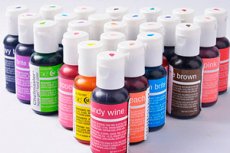Food dyes are dangerous to the intestines
Last reviewed: 07.06.2024

All iLive content is medically reviewed or fact checked to ensure as much factual accuracy as possible.
We have strict sourcing guidelines and only link to reputable media sites, academic research institutions and, whenever possible, medically peer reviewed studies. Note that the numbers in parentheses ([1], [2], etc.) are clickable links to these studies.
If you feel that any of our content is inaccurate, out-of-date, or otherwise questionable, please select it and press Ctrl + Enter.

Frequent consumption of products containing artificial food coloring - in particular, Allura red AC - provokes the development of inflammatory intraintestinal processes, including crohn's disease and ulcerative colitis. A study on this topic was conducted by representatives of Canada's McMaster University.
Various coloring components of synthetic origin are widely used by most food manufacturers. Special pigments make it possible to give products and beverages the necessary color shade. Along with dyes, flavoring, emulsifying and other substances are no less massively used. One of the most common dyes is Allura red AC - an artificial substance that gives food a red color. It is actively used in the production of yogurt, carbonated drinks, medicines, candies and cakes, etc. But until recently, experts have not been able to find a solution to this problem. But until recently, experts did not have enough information about the safety of this component for the body - in particular, for the digestive organs.
Synthetic dyes are more popular in the food industry because they impart a rich and uniform color shade, do not "bring" undesirable flavors, and have a relatively low production cost.
To understand the extent of the dye's effect on the intestine, scientists conducted a study on rodents. The first group of mice was given regular food, while the second group was offered food containing the coloring component Allura red AC. The experiment lasted for three months. At the end of this time, the scientists found that the usual amounts of dye, standardly contained in food products, provoke the development of inflammatory reactions in the intestines of rodents. And the consumption of the substance by young mice led to the development of specific Allura red AC-induced colitis. The researchers found out that the dye provoked an increase in serotonin production in the large intestine, as a result of which the epithelial functions were disturbed and the quality of intestinal flora changed.
The information announced is not only surprising, but also frightening. After all, we are talking about a common and widespread food additive that can act as a dietary trigger of inflammatory intestinal diseases not only in rodents, but also in humans. The authors of the study note that dyes, in addition to inflammatory reactions, can stimulate the development of allergic processes, immune malfunctions and even behavioral disorders - especially in childhood. In particular, we may be talking about attention deficit hyperactivity disorder - a neurobehavioral disorder, which is expressed in excessive mobility, impulsivity and difficulty with concentration.
Full details of the study can be found at of Nature Communications
